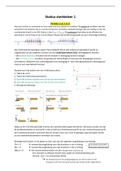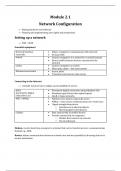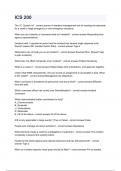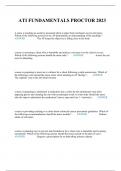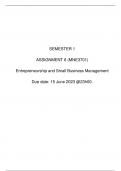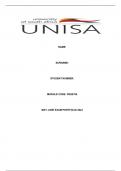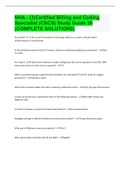474 + 2038 = a. 2512 b. 2412 c. 2521 d. 2502 - Answer A: The answer is 2512. To
solve this problem, you must know how to add numbers with multiple digits. It may be
easier for you to complete this problem if you align the numbers vertically. The crucial
thing when setting up the vertical problem is to make sure that the place values are
lined up correctly. In this problem, the larger number (2038) should be placed on top,
such that the 8 is over the 4, the 3 is over the 7, and so on. Then add the place value
farthest to the right. In this case, the 4 and the 8 that we find in the ones place have a
sum of 12; the 2 is placed in the final sum, and the 1 is carried over to the next place
value to the left, the tens. The tens place is the next to be added: 3 plus 7 equal 10, with
the addition of the carried 1 making 11. Again, the first 1 is carried over to the next place
value. The problem proceeds on in this vein.
32,788 + 1693 = a. 33,481 b. 32,383 c. 34,481 d. 36,481 - Answer C: The answer is
34,481. This problem requires that you understand addition of multiple-digit numbers.
As in the first problem, the most important step is properly aligning the two addends in
vertical formation, such that the final 8 in 32,788 is above the final 3 in 1693. Again, as
in the first problem, you will be required to carry numbers over. It is a good idea to
practice these addition problems and pay special attention to carrying over, since errors
in this area can produce answers that look correct. The makers of the HESI exam will
sometimes try to take advantage of these common errors by making a couple of the
wrong answers the results one would get by failing to carry over a digit.
3703 - 1849 = a. 1954 b. 1854 c. 1974 d. 1794 - Answer B: The answer is 1854. To
solve this problem, you must know how to subtract one multiple-digit number from
another. As with the above addition problems, the most important step in this kind of
problem is to set up the proper vertical alignment. In subtraction problems, the larger
number must always be on top, and there can be only two terms in all (an addition
problem can have an infinite number of terms). In this problem, the ones places should
be aligned such that the 3 in 3703 is above the 9 in 1849. This problem also requires
you to understand what to do when you have a larger value on the bottom of a
subtraction problem. In this case, the 3 on the top of the ones place is smaller than the
9 beneath it, so it must borrow 1 from the number to its left. Unfortunately, there is a 0 to
the left of the three, so we must extract a 1 from the next place over again. The 7 in
3703 becomes a 6, the 0 becomes a 10 only to have 1 taken away, leaving it as a 9.
The 3 in the ones place becomes 13, from which we can now subtract the 9.
4790 - 2974 = a. 1816 b. 1917 c. 2109 d. 1779 - Answer A: The answer is 1816. This
problem requires you to understand subtraction with multiple-digit numbers. As in
problem 3, the most important step is to align the problem vertically such that the 0 in
4790 is above the 4 in 2974. Again, as in problem 3, you will have to borrow from the
place value to the left when the number on the bottom is bigger than the number on top.
Be sure to practice this kind of problem with special attention to borrowing from adjacent
place values. The HESI exam will often include a few wrong answers that you could
mistakenly derive by simply forgetting to borrow.
, HESI Math Practice Test
229 × 738 = a. 161,622 b. 167,670 c. 169,002 d. 171,451 - Answer C: The answer is
169,002. To solve this problem, you must know how to multiply numbers with several
digits. These problems often intimidate students because they produce such large
numbers, but they are actually quite simple. As with the above addition and subtraction
problems, the crucial first step is to align the terms vertically such that the 8 in 738 is
above the 9 in 229. In multiplication, it is a good idea to put the larger number on top,
although it is only essential to do so when one of the terms has more place values than
the other. In a multiple-digit multiplication problem, every digit gets multiplied by every
other digit: First the 9 in 229 is multiplied by the three digits in 738, moving from right to
left. Only the digit in the ones place is brought down; the digit in the tens place is placed
above the digit to the immediate left and added to the product of the next multiplication.
In this problem, then, the 9 and 8 produce 72: The 2 is placed below, and the 7 is
placed above the 3 in 738. Then the 9 and the 3 are multiplied and produce 27, to which
the 7 is added, making 34. The 4 comes down, the 3 goes above the first 2 in 229, and
the process continues. The product of 9 multiplied by 738 is placed below and is added
to the products of 2 and 738 and 2 and 738, respectively. For each successive product,
the first digit goes one place value to the left. So, in other words, 0 is placed under the
2. These three products are added together to calculate the final product of 738 and
229.
356 × 808 = a. 274,892 b. 278,210 c. 283,788 d. 287,648 - Answer D: The answer is
287,648. This problem requires you to understand multiplication of numbers with
several digits. The difficulties you may face with this problem are identical to those of
problem 5. Be sure set up your vertical alignment properly, such that the 8 in 808 is
above the 6 in 356. Multiply the 6 in 356 by 8, 0, and 8, proceeding from right to left.
Then multiply the 5 in 356 by 8, 0, and 8; finally, multiply the 3 in 356 by 8, 0, and 8. For
each successive product, add one zero at the extreme right of the product. Add the
three products together to find your final answer.
Round to the nearest whole number: 435 ÷ 7 = a. 16 b. 62 c. 74 d. 86 - Answer B: The
answer is 62. To solve this problem, you must know how to divide a multiple-digit
number by a single-digit number. To begin with, set up the problem as . Then determine
the number of times that 7 will go into 43 (one way to do this is to multiply 7 by various
numbers until you find a product that is either 43 exactly or no more than 6 fewer than
43). In this case, you will find that 7 goes into 43 six times. Place the 6 above the 3 in
435 and multiply the 6 by 7. The product, 42, should be subtracted from 43, leaving a
difference of 1. Since 7 cannot go into 1, bring down the 5 to create 15. The 7 will go
into 15 twice, so place a 2 to the right of the 6 on top of the problem. At this point, you
should recognize that only answer choice B can be correct. If you proceed further,
however, you will find that 435 must become 435.0 so that the 0 can be brought down to
make a large enough number to be divided by 7. Once a decimal point is introduced to
the dividend, a decimal point must be placed directly above it in the quotient. If you
continue working this problem, you will end up with an answer of 62.14.... Note that the
instructions tell you only to round to the nearest whole number. Once you have solved
to the tenths place, there is no need to continue. 435 7


